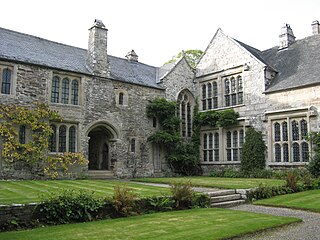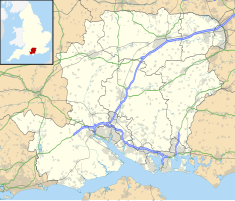
Hatfield House is a Grade I listed country house set in a large park, the Great Park, on the eastern side of the town of Hatfield, Hertfordshire, England. The present Jacobean house, a leading example of the prodigy house, was built in 1611 by Robert Cecil, 1st Earl of Salisbury and Chief Minister to King James I. It is a prime example of Jacobean architecture. The estate includes extensive grounds and surviving parts of an earlier palace. Queen Elizabeth's Oak is said to be the place where Elizabeth I was informed she had become queen. The house is currently the home of Robert Gascoyne-Cecil, 7th Marquess of Salisbury. It is open to the public.

Stourhead is a 1,072-hectare (2,650-acre) estate at the source of the River Stour in the southwest of the English county of Wiltshire, extending into Somerset.

Mentmore Towers, historically known simply as "Mentmore", is a 19th-century English country house built between 1852 and 1854 for the Rothschild family in the village of Mentmore in Buckinghamshire. Sir Joseph Paxton and his son-in-law, George Henry Stokes, designed the building in the 19th-century revival of late 16th and early 17th-century Elizabethan and Jacobean styles called Jacobethan. The house was designed for the banker and collector of fine art Baron Mayer de Rothschild as a country home, and as a display case for his collection of fine art. The mansion has been described as one of the greatest houses of the Victorian era. Mentmore was inherited by Hannah Primrose, Countess of Rosebery, née Rothschild, and owned by her descendants, the Earls of Rosebery.

Halton House is a country house in the Chiltern Hills above the village of Halton in Buckinghamshire, England. It was built for Alfred Freiherr de Rothschild between 1880 and 1883. It is used as the main officers' mess for RAF Halton and is listed Grade II* on the National Heritage List for England.

A manor house was historically the main residence of the lord of the manor. The house formed the administrative centre of a manor in the European feudal system; within its great hall were usually held the lord's manorial courts, communal meals with manorial tenants and great banquets. The term is today loosely applied to various English country houses, mostly at the smaller end of the spectrum, sometimes dating from the Late Middle Ages, which currently or formerly house the landed gentry.

Knebworth House is an English country house in the parish of Knebworth in Hertfordshire, England. It is a Grade II* listed building. Its gardens are also listed Grade II* on the Register of Historic Parks and Gardens. In its surrounding park are the medieval St. Mary's Church and the Lytton family mausoleum. It was the seat of the Earl of Lytton, and now the house of the family of the Baron Cobbold of Knebworth.

Greys Court is a Tudor country house and gardens in the southern Chiltern Hills at Rotherfield Greys, near Henley-on-Thames in the county of Oxfordshire, England. Now owned by the National Trust, it is located at grid reference SU725834, and is open to the public.

Cotehele is a medieval house with Tudor additions, situated in the parish of Calstock in the east of Cornwall, England, and now belonging to the National Trust. It is a rambling granite and slate-stone manor house on the banks of the River Tamar that has been little changed over five centuries. It was built by the Edgecumbe family in 1458 after the original Manor House was pulled down. Sir Richard Edgecumbe came into the property after fighting for Henry Tudor in the Battle of Bosworth. He was gifted with money and the original Manor House and estate and then proceeded to build Cotehele.

Luscombe Castle is a country house situated near the resort town of Dawlish, in the county of Devon in England. Upon purchasing the land at Luscombe in 1797, Charles Hoare demolished the existing house and commissioned architects John Nash and Humphrey Repton to design a new house and gardens at the site. Nash and Repton came up with an asymmetrical designed building made from Portland stone, with castellated parapets, turrets and pinnacles to create the feel of a picturesque castle.

Stourton with Gasper is a civil parish in the southwest of the English county of Wiltshire. Its main settlement is the village of Stourton, along with the hamlets of Bonham and Gasper. The village is about 2+1⁄2 miles (4 km) northwest of the small town of Mere, and is part of the Stourhead estate, which includes much of the west of the parish. The estate is in the ownership of the National Trust, and the entrance to the estate's famous house and garden is through the village.

Henry Clutton was an English architect and designer.

Lichfield Court, on Sheen Road in Richmond, London, consists of two Grade II listed purpose-built blocks of flats. Designed by Bertram Carter and built in fine Streamline Moderne style, it was completed in 1935.
William Currie,, was an English land owner, distiller, banker and Member of Parliament for Gatton and Winchelsea.
Raikes Currie was Member of Parliament (MP) for Northampton from 1837 to 1857. He was a partner of the bank Curries & Co., which became part of Glyn, Mills & Co. in 1864, along with his father, Isaac Currie, in Cornhill, City of London, and had several interests in the newly developing colony of South Australia. He restored Minley Manor and made substantial improvements to the estate, work which was continued by his son and grandson.
Minley is a slightly depopulated rural, well-wooded village in the Hart District of Hampshire, England. It has the only church of the C of E ecclesiastical parish of Minley and is in the civil parish of Blackwater and Hawley. It straddles on the A327 road between the M3 and Yateley.

The Mansion House, Old Warden Park is a 19th-century country house in Old Warden, Bedfordshire, England. Designed by Henry Clutton for Joseph Shuttleworth, it is a Grade II* listed building.

Crooked House is a 2017 mystery film directed by Gilles Paquet-Brenner, based on Agatha Christie’s 1949 novel of the same name. The film stars Max Irons, Terence Stamp, Glenn Close, Gillian Anderson, and Stefanie Martini. Principal photography began in September 2016, and the film aired in the UK on Channel 5 on 17 December 2017.

West Horsley Place is a Grade I listed building in West Horsley, to the east of Guildford in Surrey, England. There are eight further Grade II buildings on the estate, including two mid-19th-century dog kennels.

Gibraltar Barracks is a British Army installation at Minley in Hampshire.

The Secret Garden is a 2020 British fantasy drama film based on the 1911 novel of the same name by Frances Hodgson Burnett, the fourth film adaptation of the novel. Directed by Marc Munden and produced by David Heyman, it stars Dixie Egerickx, Colin Firth and Julie Walters. Set in 1947 England, the plot follows a young orphan who is sent to live with her uncle, only to discover a magical garden at his estate.


















